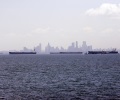The tanker market is expected to stay firm during 2023, with both demand and supply fundamentals expected to help the market to remain at high levels. In its latest weekly report, shipbroker Gibson said that “12 months ago, we titled our closing report of 2021 ‘A year to Forget’. 2022 has been anything but and summarizing what just happened on one page is no easy feat. Early in January, we then titled a report called ‘Tanker Super Cycle’, where we assessed the likelihood of the tanker market experiencing the same fortunes as the LNG and container markets. We concluded that based on the fundamentals at the time, the tanker market needed a black swan event to trigger its very own super cycle”.
According to Gibson, “on the 24th of February, Russia launched its much-feared invasion of Ukraine, and whilst Western intelligence officials had been warning of an attack, few believed Russia would follow through. Ultimately, the war triggered a path of self-sanctioning, followed by oil embargoes and price caps which are redefining oil trade flows on a scale never seen before. The resulting changes in trade flows have created large inefficiencies in oil trading, boosting tonne mile demand well beyond the pre-invasion scenario. Indeed, the slow and steady recovery we expected for most sectors has accelerated into a super cycle”.
“However, not all tankers benefitted in the same way. VLCCs were the last asset class to join the party, with their fortunes being constrained by ongoing OPEC+ production cuts, Chinese covid policy and the reshuffling of Russian oil being a largely Aframax and Suezmax play. China’s zero covid policy has clearly been a drag on the crude tanker market this year; however, with a looser policy heading into 2023, China is forecast to contribute nearly half of all demand growth”, the shipbroker noted.
“The strength of the tanker market this year has prevailed against a gloomy economic outlook, with high inflation and hawkish monetary policy dominating sentiment in financial markets. However, despite this backdrop, oil production growth has surged by 4.7mbd this year, driven largely by gains in the Americas and the unwinding of OPEC+ production cuts, whilst refinery throughputs also gained 2.3mbd year on year as diesel refining margins strengthened on the back of recovering demand, gas to oil switching and supply concerns from Russia”, Gibson said.
The shipbroker added that “with all the disruptions to oil trade this year, it is perhaps surprising that oil prices are currently trading towards the bottom of their high/low range. This year Brent prices peaked at $127.98/bbl in the weeks following the invasion, and bottomed out at $76.10/bbl last week, averaging $99.65/bbl for the year to date. Ultimately this suggests that the price surge following the invasion was sentiment driven, whereas prices today reflect less concern over global oil supply/demand balances, despite import bans and the price cap. However, it is early days and only time will tell where the fundamentals truly lie. On some routes, freight rates have averaged at record levels this year. LR2s on the Middle East/UK Cont run have averaged $4.1m so far in 2022 vs. a previous record average of $3.4m in 2008. Other routes may not have averaged at record levels, but have briefly seen all-time highs, such as the Aframax cross Caribbean route, which briefly hit WS640. For routes involving Russia, the sky may well be the limit”.
“High freight rates and demand for older tonnage (much of which will likely trade Russia) have also led to exceptional increases in asset values. The price of a 10-year-old Aframax has increased more than 50% from January to December, reaching levels not seen since 2008. Newbuild prices have also continued to rise this year, which depending on the asset size, are up 5-8%. Although this trails the strong growth seen in secondhand prices, it is important to note that newbuild prices had already gained over 25% in 2021 (asset class dependent), with yard availability remaining tight and cost inflation for materials and labor persisting. Tanker newbuilding orders this year sit at the lowest level since 2016, meaning that the orderbook continued to deplete. This year, just 7.95mdwt of crude and product tankers have been ordered, against deliveries totaling 26.4mdwt. 5.2mdwt has been sold for demolition, which given firm secondhand prices for older tankers, is hardly surprising. Overall, the tanker market in 2022 has been transformed owing to terrible circumstances. It is impossible to say how long the war will persist, but for now, with few signs of peace, and permanent changes to the world’s relationship with Russia, shipowners have good reason to remain bullish into 2023”, Gibson concluded.
Source: Hellenic Shipping News






